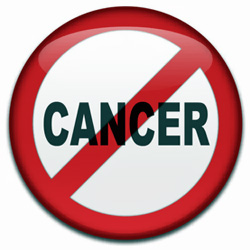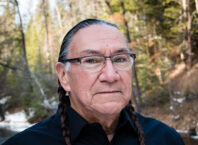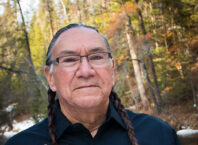Rachel Lynch
According to the Rosewell Park Cancer Center, there are more than 5 million Native Americans that belong to over 500 nationally recognized tribes living in the United States. Many of these Native Americans have differences when it comes to culture and traditions, but the one thing that holds true to all of them, is the disproportionate effect that cancer has played in their communities. While there are many contributing factors that cannot be changed, there is a lot that can be done to help Native Americans, as a community, beat cancer.
On average, there are certain types of cancers that affect Native Americans more than other populations. According to the National American Indian Cancer Foundation, cancer is one of the top leading causes of death for both Native American men and women. Typically, women are most affected by breast, lung, and colorectal cancer; and men are most affected by prostate, lung, and colorectal cancer. As one can tell, lung cancer is a disease that greatly impacts the community. Furthermore, the types of cancer affecting different tribes can vary regionally.
Asbestos
One of the major contributors to the high rates of lung cancer in Native American communities is asbestos. Asbestos is a natural fiber that was predominately used for construction, due to its heat resistant qualities. However, when this microscopic toxin is inhaled, it becomes a major threat to human health. Sticking to the walls of the lungs and other internal organs, it remains dormant for 10-50 years until it causes lung cancer at a later time. The lung cancer most closely associated with asbestos exposure is mesothelioma and it has no known cure. This also contributes to lung cancer being the second most common cancer for both Native men and women.
This substance is extremely prevalent in the Native American community, considering many Native Americans historically have worked blue collar occupations where they are more likely to come into contact with asbestos. The occupational worker in the family can bring the substance home on his or her clothing, and unknowingly spread the carcinogen around a home. This second-hand exposure is usually how many women and children develop mesothelioma.
Occupational exposure is one way people are exposed to asbestos, but many Native Americans are exposed to asbestos through what is known as fly tipping. Fly tipping, being the illegal dumping on lands, is something that happens regularly with asbestos-containing products and has happened repeatedly to the Native American people and their land over generations. With the asbestos being dumped on reservations without the community’s knowledge, many Native Americans are exposed to this carcinogen through both air and water, leading to the development of respiratory illnesses.
Health Care
Despite regional differences, many Native Americans can be affected by various cancers, due to genetics and lifestyle, but there are also reasons that remain outside of the community’s control that contribute to the high volume of cancer riddling the Native American community. Regardless of the reasons that cannot be controlled, one of the things that can be changed, is the state of healthcare on reservations.
Many Native Americans who live on reservations do have access to the Indian Health Service (IHS), but the organization is debilitatingly underfunded. Thanks to the high levels of poverty within the community, the organizations available are on average subpar due to this and the lack of federal funding. To put in perspective how underfunded organization like this are, it is reported that the federal government spends almost twice as much on healthcare for prisoners in comparison to Native Americans. With this being a factor, many patients are forced to take their health needs elsewhere. Many will have to drive or have a family member go with them to a better facility off the reservation, which is usually hours away.
Many may argue that tribes should be considered their own entity rather than being grouped in as a race of people in the United States. However, according to the Supreme Court, tribal citizenship is not only a racial classification, but also a political one, and since the nations operate on their own, the U.S. government is essentially dealing with an outside entity. At the same time, the U.S. has recognized that generations of mistreatment of the Native people has made tribes significantly dependent on the federal government.
The federal government has voluntarily taken responsibility for these people due to this, but again, there are problems with the amount of funding and the stigma around these people’s financial stability. For example, Trump has been reported saying that to resolve both the financial and healthcare situations for the Native people is to enstate that those without employment will not be given healthcare. This is extremely frustrating for those who have little to no career opportunities on the reservation. Many Natives are fighting back with the Affordable Care Act.
Proper Data Collection
Communication about the state of the Native Americans’ health is far and few between. There is minimal data available as to why so many Natives are affected by cancer. According to the CDC many hospital records and death records are inaccurate and thanks to this, the information needed to help the Native people decrease cancer diagnosis rates is often missing or inaccurate. The CDC reported that nearly 30 percent of those who identify themselves as Native American or Alaskan Native are identified as the incorrect race at time of death.
While this may not seem like it makes a difference, it in fact does. Connecting cancer registry and death reports to a person’s race is called linkage and by identifying the Native American people as another race, this skews important data that researchers need to help tribes solve their cancer epidemics. By being able to properly connect this information and correctly report race at time of death for Native Americans, this hopefully can help collect the proper data needed to resolve this issue.
While these are not the only reasons that Native Americans are affected by cancer, healthcare, proper data collection, and human carcinogens like asbestos each play a significant role in tribal communities cancer rates. The Native people are fighting back to help their communities stay healthy and informed about the effects of cancer.
The 2017 Spirits of EAGLES National Conference is one example of the many efforts to shed light on these issues. By bringing attention to these communities and to the federal government, these organizations hope to bring more resources to those Native Americans who are struggling with cancer and other debilitating diseases.






